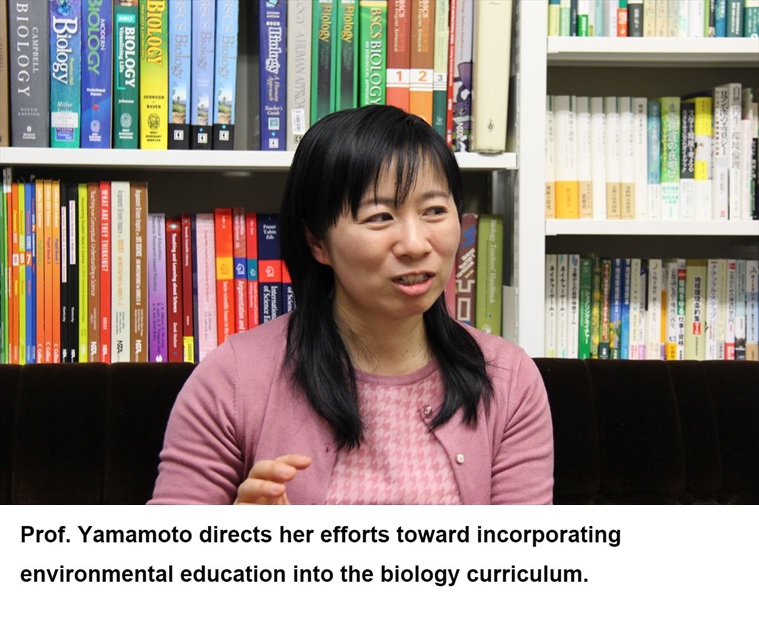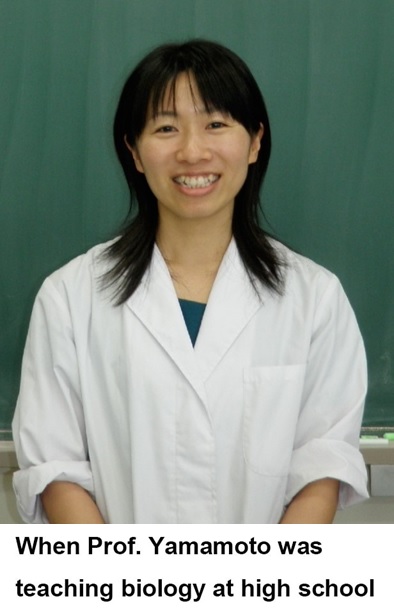TSUKUBA FUTURE
#087 Immersed in Deep Ecology
Assistant Professor YAMAMOTO Yoko, Faculty of Human Sciences

Caring for the environment is easy to talk about, but in the classroom, how do you actually teach this philosophy and get people to take action? What makes the environment important in the first place? Environmental science, ecology, environmental philosophy and environmental ethics all mean something different depending on the person. Remarkable among all these fields is environmental education based on deep ecology.
Environmental education began in the 1970s in Japan amid pollution problems and the need for environmental conservation. At that time, industrial polluters and developers were seen as the perpetrators, and regular people as the victims whose health and natural environment suffered. In the 80s, it became apparent that perhaps everyone was responsible for destruction of the ozone layer, depletion of natural resources, global warming, deforestation and other environmental problems. At the same time, it became clear that focus on the global ecosystem was necessary in order to grasp and resolve these problems. The importance of environmental education to the contemplation of the value of nature and of environmental ethics became greater than ever.

As in the rest of the world, Japan saw a transition from pollution and environmental contamination toward environmental conservation, and even the birth of an environmentalism movement. Influential in the global environmental movement was the Norwegian philosopher Arne Naess, who coined the term "deep ecology" in the mid-1970s. The deep ecology philosophy first took root in the ideas of Spinoza and Gandhi, and was also greatly influenced by Zen philosophy and the American naturalists Thoreau, Leopold and Carson. According to Prof. Yamamoto, the core of this environmental ethics is self-realization - spiritual growth and maturity in identification with all of nature - and the belief that all living beings are equal.
In her high school days, Prof. Yamamoto wanted to find a job where she could contribute to solving environmental problems. At the time, she wondered if chemistry research might lead to a solution for industrial pollution. But it was a chance encounter with the book Silent Spring by Rachel Carson that completely changed her future. She decided against chemistry, and switched her focus to the study of living things, especially ecology. She entered the Animal Ecology Lab at the University of Tsukuba where she selected a field of study based on the behavioral observation of ants in the university's botanical garden. Because of the difficulty of data collection in actual field work, however, she agonized about her future. Then, a senior student in her lab told her about the environmental education field. Prof. Yamamoto realized that this was what she had always wanted to do, and continued on to a master's program in the Science Education Course at the University of Tsukuba's graduate school. As she developed and worked on the environmental education program, she discovered deep ecology education.
 The Japanese curriculum for environmental education includes a variety of subjects, focused on science, geography, morals and civics. At Biological Sciences Curriculum Study (BSCS) of the US, students are asked to consider their own position in regard to the opposing ethics of anthropocentric environmentalism and deep ecology. The former concerns itself with the use of the environment for human-centered purposes, and the latter is that described above, in which all living things are of equal standing. In addition, in the west, different deep ecology environmental education programs sponsored by different private organizations exist. Prof. Yamamoto spent two years in graduate school and the next fifteen years as a high school teacher intermittently trying out different combinations of these outlooks in the Japanese education system. Without using or explaining the term "deep ecology," she brought students into contact with vegetation in the school yard (experiences of identification with familiar nature), at times encouraging them to lie down on a sheet and experience how the trees "feel" in order to come closer to nature. Students' responses were often "I feel better," "I feel calm" or "I feel like nature brings me to life." A separate survey of students showed a high affinity with an ethic of equality of all living beings.
The Japanese curriculum for environmental education includes a variety of subjects, focused on science, geography, morals and civics. At Biological Sciences Curriculum Study (BSCS) of the US, students are asked to consider their own position in regard to the opposing ethics of anthropocentric environmentalism and deep ecology. The former concerns itself with the use of the environment for human-centered purposes, and the latter is that described above, in which all living things are of equal standing. In addition, in the west, different deep ecology environmental education programs sponsored by different private organizations exist. Prof. Yamamoto spent two years in graduate school and the next fifteen years as a high school teacher intermittently trying out different combinations of these outlooks in the Japanese education system. Without using or explaining the term "deep ecology," she brought students into contact with vegetation in the school yard (experiences of identification with familiar nature), at times encouraging them to lie down on a sheet and experience how the trees "feel" in order to come closer to nature. Students' responses were often "I feel better," "I feel calm" or "I feel like nature brings me to life." A separate survey of students showed a high affinity with an ethic of equality of all living beings.
By taking time to become more intimately acquainted with nature, students came away with profound experiences. Prof. Yamamoto's research has now shifted to incorporating the new concept of biophilia into environmental education in order to foster greater awareness of environmental ethics. Biophilia is the hypothesis that people have an innate love for nature and other living things. Assuming that this hypothesis is true, if programs are developed to foster that feeling from a young age, awareness of environmental ethics would develop on its own. Prof. Yamamoto directs her efforts not toward outspoken calls for environmental ethics, but toward a world and an education system intimately connected to nature that cultivates those ethics.
Article by Science Communicator at the Office of Public Relations



